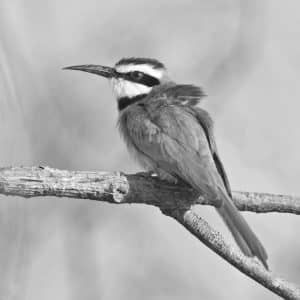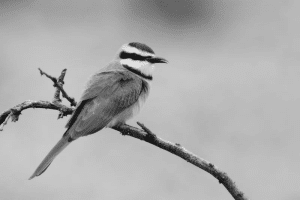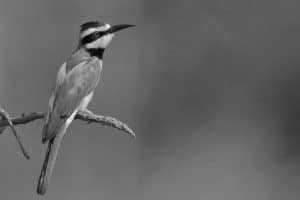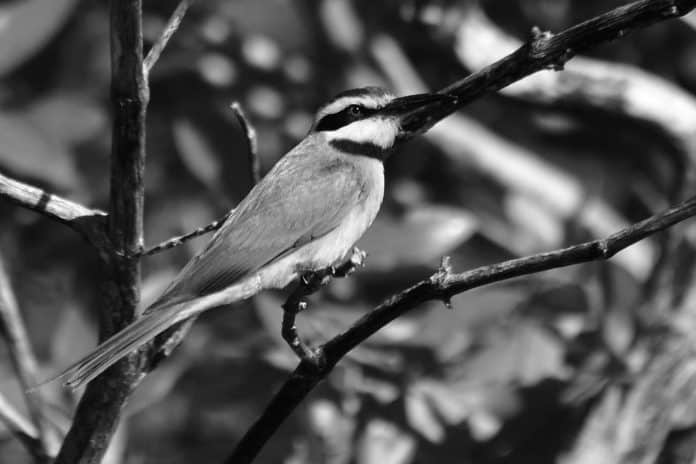Introduction to the White-Throated Bee-Eater
Welcome to the enchanting world of the white-throated bee-eater, a striking bird species that graces the Tanzanian canopies with its vibrant presence. The white-throated bee-eater in Tanzania, scientifically known as Merops albicollis, is a member of the bee-eater family and is renowned for its captivating appearance and graceful aerial acrobatics. These birds are a true spectacle to behold, with their exquisite plumage and agile hunting techniques. As we delve into the realm of the white-throated bee-eater, we will unravel the intricacies of its habitat, behavior, and ecological significance, providing a comprehensive understanding of this avian gem that adorns the Tanzanian landscape.
Habitat and Distribution of the White-Throated Bee-Eater in Tanzania

The white-throated bee-eater is predominantly found in sub-Saharan Africa, including the beautiful landscapes of Tanzania. These elegant birds are known to inhabit a variety of habitats, ranging from woodlands and savannas to riverbanks and open grasslands. Their presence is particularly prominent in the eastern and southern regions of Tanzania, where they thrive in areas with suitable nesting sites and an abundant supply of insect prey. The lush canopies and riverine forests of Tanzania provide an ideal sanctuary for the white-throated bee-eater, offering a rich tapestry of flora and fauna that sustains their way of life.
These birds are highly adaptable and can be observed in both natural and human-altered environments, showcasing their resilience in the face of changing landscapes. The distribution of the white-throated bee-eater in Tanzania is a testament to the diverse ecosystems that support their existence, highlighting the interconnectedness of wildlife and the environment. By understanding their habitat and distribution, we gain valuable insight into the ecological dynamics that shape the lives of these remarkable avian inhabitants.
Physical Characteristics and Behavior of the White-Throated Bee-Eater
The white-throated bee-eater is adorned with a striking ensemble of colors, featuring a predominantly green plumage complemented by a white throat and a touch of chestnut on the crown and upper back. Their slender, elongated bodies and distinctive black eye stripes further contribute to their captivating appearance, making them a sight to behold amidst the verdant foliage of Tanzanian canopies. These birds are not only renowned for their visual splendor but also for their remarkable aerial prowess, as they skillfully dart through the air in pursuit of their insect prey.
In addition to their agile flight, white-throated bee-eaters exhibit fascinating social behaviors, often congregating in small groups or pairs as they forage and engage in courtship displays. Their melodious calls and synchronized movements add a symphonic dimension to the Tanzanian skies, creating a sensory experience that resonates with the natural rhythm of the environment. By delving into the physical characteristics and behavior of the white-throated bee-eater, we gain a deeper appreciation for the intricate tapestry of nature’s creations and the wondrous adaptations that shape their lives.
Breeding and Nesting Habits of the White-Throated Bee-Eater
The breeding season heralds a time of heightened activity for the white-throated bee-eater, as they embark on the intricate process of courtship, nest building, and rearing of their young. These birds are known for their communal nesting habits, often forming colonies in riverbanks or sandy cliffs where they excavate burrows for their nests. The female bee-eater lays a clutch of eggs within these earthen chambers, and both parents partake in the vital task of incubating the eggs and caring for the fledglings upon hatching.
The cooperative nature of their breeding colonies and the nurturing efforts of the adult bee-eaters underscore the intricate social dynamics that govern their reproductive success. The sight of these vibrant birds tending to their young in the Tanzanian landscape serves as a poignant reminder of the enduring bonds that unite families in the natural world. By exploring the breeding and nesting habits of the white-throated bee-eater, we gain insight into the delicate balance of life and the interwoven tapestry of relationships that define their existence.
Conservation Status and Threats to the White-Throated Bee-Eater in Tanzania
Despite their resilience and adaptability, the white-throated bee-eater faces a range of threats that impact their populations in Tanzania. Habitat loss due to deforestation, agricultural expansion, and human development poses a significant challenge to the well-being of these birds, diminishing the availability of suitable nesting sites and foraging grounds. Furthermore, the indiscriminate use of pesticides and insecticides in agricultural practices can lead to a decline in insect populations, thereby affecting the primary food source of the white-throated bee-eater.
In addition to these environmental pressures, the illegal wildlife trade and poaching activities pose a grave threat to the conservation of the white-throated bee-eater and other avian species in Tanzania. The demand for exotic birds and their plumage contributes to the illicit trade, jeopardizing the survival of these majestic creatures. It is imperative to raise awareness about the conservation status of the white-throated bee-eater and advocate for measures that safeguard their habitats and mitigate the impacts of human-induced threats. By understanding the challenges they face, we can work towards securing a sustainable future for these iconic avian ambassadors of Tanzanian canopies.
Best Locations for Observing the White-Throated Bee-Eater in Tanzanian Canopies

Tanzania is blessed with an abundance of natural wonders, and the best locations for observing the white-throated bee-eater offer a glimpse into the mesmerizing tapestry of its avian inhabitants. The lush riverine forests along the Rufiji River in the Selous Game Reserve provide a prime habitat for these birds, offering ample opportunities to witness their vibrant plumage and aerial displays. The Tarangire National Park is another renowned sanctuary for the white-throated bee-eater, with its sprawling savannas and ancient baobab trees providing a picturesque backdrop for birdwatching enthusiasts.
The Usambara Mountains are a hidden gem for observing the white-throated bee-eater, as the verdant slopes and misty canopies harbor a diverse array of bird species, including these graceful avian residents. For those seeking a coastal adventure, the Saadani National Park presents an idyllic setting to witness the white-throated bee-eater in its natural habitat, amidst the convergence of land and sea. These locations offer a tapestry of landscapes and ecosystems that showcase the beauty and diversity of Tanzanian canopies, providing a captivating backdrop for observing the white-throated bee-eater in all its splendor.
Tips for Birdwatching and Photographing the White-Throated Bee-Eater
Birdwatching and photographing the white-throated bee-eater in Tanzanian canopies provide an opportunity to immerse oneself in the wonders of avian ecology and capture moments of natural beauty. When venturing into the wilderness to observe these birds, it is essential to practice responsible wildlife viewing and minimize disturbances to their natural behaviors. Patience and attentiveness are key virtues for birdwatching, as the elusive nature of the white-throated bee-eater demands a keen eye and a quiet presence.
For photography enthusiasts, the early morning and late afternoon hours present optimal lighting conditions for capturing the vibrant hues and graceful movements of the white-throated bee-eater. Utilizing a telephoto lens and maintaining a respectful distance from the birds allows for stunning close-up shots while ensuring their well-being is prioritized. By embracing the art of birdwatching and photography, enthusiasts can forge a deeper connection with the natural world and foster a sense of appreciation for the avian marvels that grace the Tanzanian canopies.
Importance of the White-Throated Bee-Eater in Tanzanian Ecosystems
The white-throated bee-eater plays a pivotal role in the ecological tapestry of Tanzanian ecosystems, contributing to the delicate balance of predator-prey dynamics and the regulation of insect populations. As voracious insectivores, these birds help control the abundance of flying insects, including bees, wasps, and dragonflies, thereby exerting a beneficial influence on the ecological equilibrium of their habitats. Their presence also serves as an indicator of ecosystem health, reflecting the vitality of the surrounding landscapes and the availability of suitable resources for avian sustenance.
Furthermore, the cultural and aesthetic significance of the white-throated bee-eater enriches the tapestry of human-wildlife interactions, inspiring awe and admiration for the natural world. These birds are revered for their elegant plumage and graceful demeanor, weaving a narrative of avian splendor that resonates with the collective consciousness of Tanzanian biodiversity. By recognizing the importance of the white-throated bee-eater in Tanzanian ecosystems, we honor the interconnectedness of all life forms and the intrinsic value of preserving their presence for future generations to cherish.
Efforts and Initiatives for the Protection of the White-Throated Bee-Eater

In light of the conservation challenges faced by the white-throated bee-eater, various efforts and initiatives have been established to safeguard the well-being of these avian treasures in Tanzanian canopies. Conservation organizations and local communities have collaborated to implement habitat restoration projects, creating protected areas and wildlife corridors that support the nesting and foraging requirements of the white-throated bee-eater. These initiatives aim to mitigate the impact of habitat loss and promote sustainable land management practices that benefit both wildlife and local livelihoods.
Furthermore, educational programs and public outreach activities have been instrumental in raising awareness about the conservation status of the white-throated bee-eater, fostering a sense of stewardship and environmental responsibility among diverse audiences. By engaging in citizen science initiatives and promoting ecotourism opportunities, these efforts contribute to the collective endeavor of preserving the natural heritage of Tanzania and nurturing the coexistence of humans and wildlife. Through collaborative action and steadfast dedication, the protection of the white-throated bee-eater stands as a testament to the enduring commitment to conservation and the harmonious cohabitation of avian marvels in Tanzanian canopies.
Conclusion
In conclusion, the white-throated bee-eater epitomizes the elegance and vibrancy of avian life in Tanzanian canopies, enriching the natural landscape with its resplendent presence and ecological significance. From the verdant woodlands to the meandering riverbanks, these birds weave a tale of grace and resilience, embodying the timeless allure of wildlife in their captivating plumage and aerial ballet. As stewards of the natural world, it is our collective responsibility to cherish and protect the white-throated bee-eater, ensuring that future generations have the opportunity to marvel at the throat of elegance that adorns the Tanzanian skies. By celebrating their beauty, understanding their ecological importance, and advocating for their conservation, we embrace the spirit of kinship with nature and honor the enduring legacy of the white-throated bee-eater in Tanzanian canopies.


































